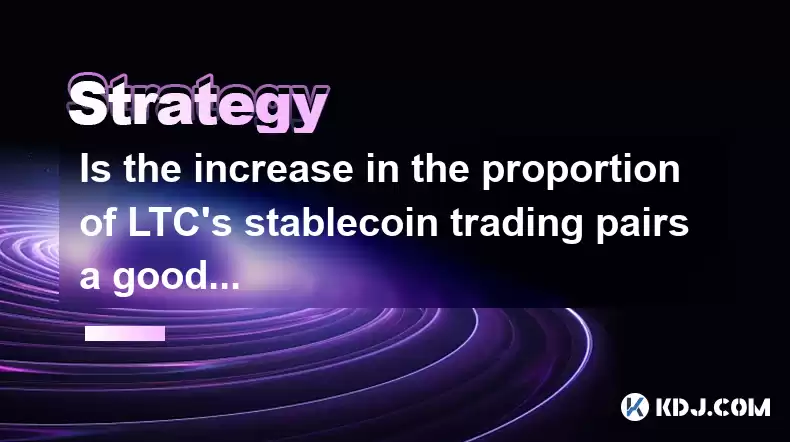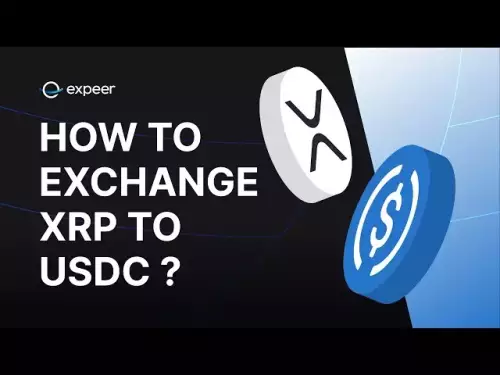-
 bitcoin
bitcoin $112715.707551 USD
-1.71% -
 ethereum
ethereum $4101.475385 USD
-3.01% -
 tether
tether $1.000644 USD
-0.02% -
 bnb
bnb $1207.619465 USD
-6.77% -
 xrp
xrp $2.501451 USD
-3.98% -
 solana
solana $202.947124 USD
-3.32% -
 usd-coin
usd-coin $1.000295 USD
0.04% -
 dogecoin
dogecoin $0.203884 USD
-4.47% -
 tron
tron $0.317154 USD
-1.72% -
 cardano
cardano $0.695009 USD
-4.43% -
 hyperliquid
hyperliquid $38.853961 USD
-8.23% -
 chainlink
chainlink $18.988674 USD
-4.64% -
 ethena-usde
ethena-usde $1.000233 USD
-0.03% -
 stellar
stellar $0.337050 USD
-3.63% -
 bitcoin-cash
bitcoin-cash $536.861728 USD
-1.28%
Is the increase in the proportion of LTC's stablecoin trading pairs a good thing?
Increased LTC/stablecoin trading pairs enhance liquidity and reduce volatility exposure, but may centralize trading volume and rely heavily on stablecoin stability.
Apr 26, 2025 at 09:01 pm

The topic of whether the increase in the proportion of Litecoin (LTC)'s stablecoin trading pairs is a good thing is multifaceted and can be analyzed from various perspectives within the cryptocurrency ecosystem. This discussion will delve into the implications of this trend, examining its potential benefits and drawbacks, and how it might affect the overall dynamics of the Litecoin market.
Understanding Stablecoin Trading Pairs
Stablecoins are cryptocurrencies designed to minimize the volatility typically associated with other digital assets like Bitcoin or Litecoin. They are often pegged to a stable asset, such as the US dollar, to maintain a steady value. When a cryptocurrency like Litecoin has trading pairs with stablecoins, it means that LTC can be directly traded for these stablecoins on various exchanges.
The increase in the proportion of LTC's stablecoin trading pairs signifies a shift in the trading landscape. More exchanges are offering LTC/stablecoin pairs, and a higher volume of trades are being conducted through these pairs. This trend can be attributed to the growing acceptance and use of stablecoins within the crypto community.
Benefits of Increased Stablecoin Trading Pairs
One of the primary advantages of having more stablecoin trading pairs for LTC is increased liquidity. Liquidity refers to the ease with which an asset can be bought or sold without affecting its price significantly. When there are more trading pairs available, especially with stablecoins, it becomes easier for traders to enter and exit positions quickly. This is particularly beneficial for traders who want to move in and out of LTC without the need to convert their holdings into a fiat currency.
Another benefit is reduced volatility exposure. Trading LTC against stablecoins allows traders to mitigate the risk associated with the volatility of other cryptocurrencies. For instance, if a trader wants to hold LTC but is concerned about the price swings of Bitcoin or Ethereum, they can trade LTC against a stablecoin like USDT (Tether) or USDC (USD Coin). This can provide a more stable trading environment, which is attractive to both novice and experienced traders.
Potential Drawbacks of Increased Stablecoin Trading Pairs
Despite the advantages, there are also potential drawbacks to consider. One concern is the concentration of trading volume. If a significant portion of LTC trading shifts to stablecoin pairs, it might lead to a decrease in trading volume on other pairs, such as LTC/BTC or LTC/ETH. This could potentially reduce the overall liquidity of LTC across the market, as the trading activity becomes more centralized on stablecoin pairs.
Another issue is the reliance on stablecoins. Stablecoins are not without their own risks. They are subject to regulatory scrutiny, and there have been instances where stablecoins have de-pegged from their intended value. If a large portion of LTC trading is dependent on stablecoins, any instability in the stablecoin market could have a ripple effect on LTC trading.
Impact on Litecoin's Market Dynamics
The increase in stablecoin trading pairs can also influence the overall market dynamics of Litecoin. For instance, price discovery might be affected. Price discovery is the process by which the market determines the price of an asset. With more trading activity on stablecoin pairs, the price of LTC might be more influenced by the trading dynamics of these pairs, potentially leading to different price movements compared to when trading was more diversified across various pairs.
Additionally, market sentiment could be impacted. The availability of stablecoin trading pairs might attract a different type of trader to the Litecoin market. Traders who are more risk-averse might be drawn to LTC/stablecoin pairs, potentially shifting the overall sentiment of the market towards more conservative trading strategies.
Case Studies and Real-World Examples
To illustrate the impact of increased stablecoin trading pairs on LTC, let's look at a few real-world examples. On major exchanges like Binance and Coinbase, the volume of LTC/USDT trading pairs has seen significant growth over the past year. This increase in trading volume suggests that more traders are opting for the stability offered by trading LTC against USDT rather than other cryptocurrencies.
In another example, the introduction of LTC/USDC pairs on exchanges like Kraken has provided traders with an alternative stablecoin option. This diversification of stablecoin pairs has allowed traders to choose the stablecoin that best suits their needs, further enhancing the liquidity and trading options available for LTC.
User Experience and Accessibility
From a user experience perspective, the increase in stablecoin trading pairs can make trading LTC more accessible. Simplified trading processes are a significant advantage. For instance, if a user wants to buy LTC with fiat currency, they might first need to convert their fiat into Bitcoin or Ethereum before trading for LTC. With stablecoin pairs, they can directly trade their fiat for a stablecoin and then for LTC, streamlining the process.
Moreover, lower transaction fees can be another benefit. Trading LTC against stablecoins often incurs lower fees compared to trading against other cryptocurrencies. This can make trading more cost-effective for users, encouraging more participation in the LTC market.
Frequently Asked Questions
Q: How can I start trading LTC with stablecoins?- Choose a reputable cryptocurrency exchange that offers LTC/stablecoin trading pairs, such as Binance or Coinbase.
- Create an account on the exchange and complete the necessary verification processes.
- Deposit funds into your account, either in fiat currency or another cryptocurrency.
- If you deposit fiat, convert it to a stablecoin like USDT or USDC.
- Navigate to the LTC/stablecoin trading pair on the exchange.
- Place your trade, either buying or selling LTC against the stablecoin.
- Yes, there are risks. Stablecoins can de-peg from their intended value, which could affect the value of your trades.
- Regulatory changes can impact the stability and availability of stablecoins.
- While trading against stablecoins can reduce volatility exposure, it does not eliminate all risks associated with cryptocurrency trading.
- It can lead to increased liquidity for specific cryptocurrencies like LTC, making them more attractive to traders.
- It might shift trading volume away from other pairs, potentially affecting the liquidity and price discovery of those pairs.
- It can attract a different type of trader to the market, potentially influencing market sentiment and trading strategies.
- Yes, if a significant portion of trading volume shifts to stablecoin pairs, it could lead to more centralized trading activity on those pairs.
- This centralization might reduce the overall liquidity of the cryptocurrency across other trading pairs.
- However, the introduction of multiple stablecoin pairs can also diversify trading options, potentially mitigating some centralization effects.
Disclaimer:info@kdj.com
The information provided is not trading advice. kdj.com does not assume any responsibility for any investments made based on the information provided in this article. Cryptocurrencies are highly volatile and it is highly recommended that you invest with caution after thorough research!
If you believe that the content used on this website infringes your copyright, please contact us immediately (info@kdj.com) and we will delete it promptly.
- Coinbase vs. Binance: Navigating the BNB Listing Landscape
- 2025-10-16 06:40:01
- Canadian Coin Alert: Is That Gold Penny Worth a Fortune?
- 2025-10-16 06:40:01
- PayPal, PYUSD, and Stablecoins: Riding the Wave of Digital Finance
- 2025-10-16 04:50:01
- Milk Mocha's $HUGS Token: Why the Whitelist & Presale 2025 are Exploding
- 2025-10-16 04:30:01
- DeepSnitch AI: The Next Big Thing on BNB Chain and Binance Listings?
- 2025-10-16 05:43:02
- Microsoft, Bitcoin, and GitHub: A Balancing Act in the Digital Age
- 2025-10-16 04:30:01
Related knowledge

Practical parameter settings for a Bitcoin multi-timeframe moving average system
Sep 18,2025 at 10:54pm
Optimizing Timeframe Combinations for Bitcoin Trading1. Selecting appropriate timeframes is crucial when building a multi-timeframe moving average sys...

How can I filter out false breakouts in Dogecoin high-frequency trading?
Sep 22,2025 at 01:00am
Understanding False Breakouts in Dogecoin Trading1. A false breakout occurs when Dogecoin's price appears to move beyond a defined support or resistan...

Techniques for identifying tops and bottoms in the Bitcoin on-chain NVT model
Sep 20,2025 at 07:54pm
Understanding the NVT Model in Bitcoin Analysis1. The Network Value to Transactions (NVT) ratio is often described as the 'P/E ratio' of the cryptocur...

What does the surge in open interest in Bitcoincoin futures mean?
Sep 20,2025 at 11:18pm
Understanding the Surge in Dogecoin Futures Open Interest1. A surge in open interest within Dogecoin futures indicates a growing number of active cont...

How can I use the Ethereum USDT premium to gauge market sentiment?
Sep 18,2025 at 11:55pm
Understanding the Ethereum USDT Premium1. The Ethereum USDT premium refers to the price difference between USDT (Tether) traded on Ethereum-based plat...

What should I do if Ethereum staking yields decline?
Sep 20,2025 at 06:18am
Understanding the Causes Behind Declining Ethereum Staking Yields1. The Ethereum network transitioned to a proof-of-stake consensus mechanism with the...

Practical parameter settings for a Bitcoin multi-timeframe moving average system
Sep 18,2025 at 10:54pm
Optimizing Timeframe Combinations for Bitcoin Trading1. Selecting appropriate timeframes is crucial when building a multi-timeframe moving average sys...

How can I filter out false breakouts in Dogecoin high-frequency trading?
Sep 22,2025 at 01:00am
Understanding False Breakouts in Dogecoin Trading1. A false breakout occurs when Dogecoin's price appears to move beyond a defined support or resistan...

Techniques for identifying tops and bottoms in the Bitcoin on-chain NVT model
Sep 20,2025 at 07:54pm
Understanding the NVT Model in Bitcoin Analysis1. The Network Value to Transactions (NVT) ratio is often described as the 'P/E ratio' of the cryptocur...

What does the surge in open interest in Bitcoincoin futures mean?
Sep 20,2025 at 11:18pm
Understanding the Surge in Dogecoin Futures Open Interest1. A surge in open interest within Dogecoin futures indicates a growing number of active cont...

How can I use the Ethereum USDT premium to gauge market sentiment?
Sep 18,2025 at 11:55pm
Understanding the Ethereum USDT Premium1. The Ethereum USDT premium refers to the price difference between USDT (Tether) traded on Ethereum-based plat...

What should I do if Ethereum staking yields decline?
Sep 20,2025 at 06:18am
Understanding the Causes Behind Declining Ethereum Staking Yields1. The Ethereum network transitioned to a proof-of-stake consensus mechanism with the...
See all articles










































































